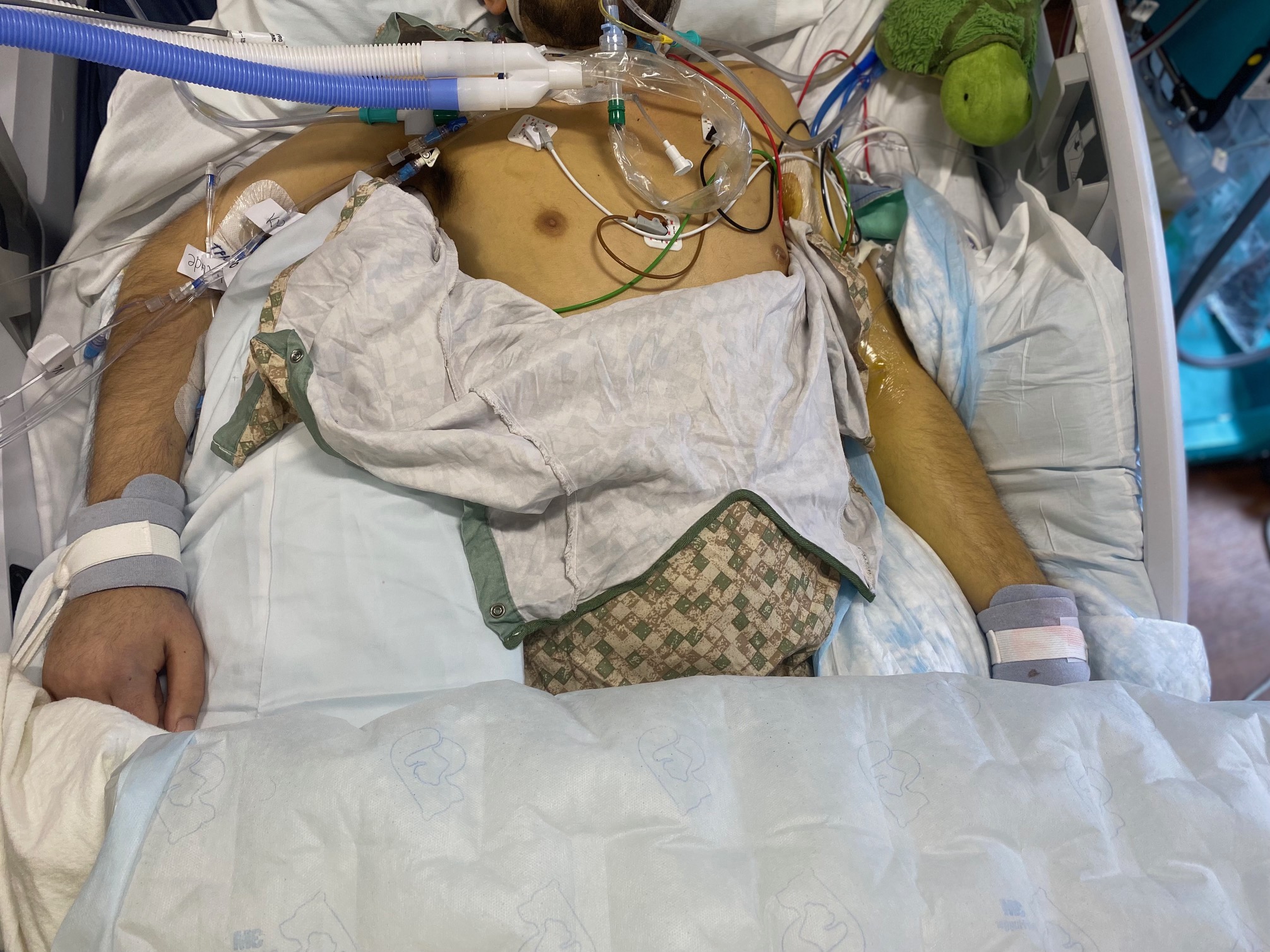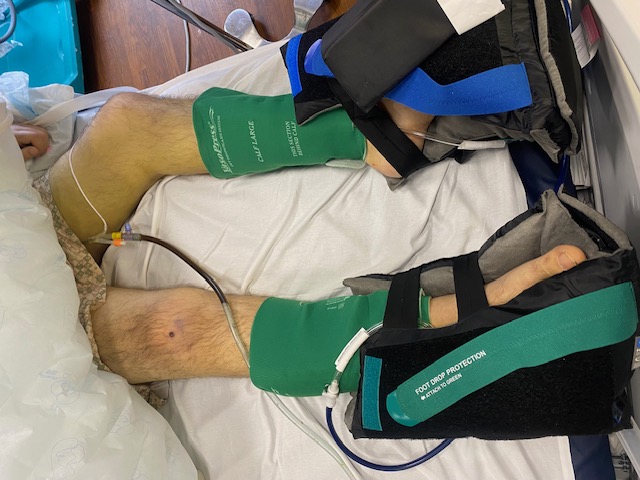Sunday Poster Session
Category: Liver
P1696 - A Rare Presentation of Asymmetrical Jaundice
Sunday, October 26, 2025
3:30 PM - 7:00 PM PDT
Location: Exhibit Hall

Timothy Chan, BS
SUNY Upstate Medical University
Syracuse, NY
Presenting Author(s)
Timothy Chan, BS1, Ahmed Shehadah, MD2, Almothana Manasrah, MD3, Amanke Oranu, MD2
1SUNY Upstate Medical University, Syracuse, NY; 2United Health Services, Wilson Medical Center, Binghamton, NY; 3United Health Services, Wilson Medical Center, Johnson City, NY
Introduction: Jaundice is a systemic sign of elevated serum bilirubin that typically presents in a widespread, symmetrical distribution; here, we describe an atypical case of asymmetrical jaundice with associated edema in a young cirrhotic male patient.
Case Description/
Methods: A 31-year-old male patient with a history of alcohol use, hepatitis C cirrhosis, and polysubstance abuse was admitted to the intensive care unit for management of toxic metabolic encephalopathy, gram-negative bacteremia, kidney failure, and shock. He was found to have a distended abdomen with large ascites; paracentesis was performed on the first and third day of admission, both in the right lower quadrant of his abdomen. On day four of admission, he was found to have more pronounced pitting edema in his left extremities compared to his right. He also had jaundice involving his entire torso and left side; however, his right arm and his entire right lower extremity were spared from both jaundice and edema. His bilirubin increased from 13.1 mg/dL from admission to 21.8 mg/dL by day five. His pattern of asymmetrical jaundice and edema persisted until he passed away on the eighth day of admission.
Discussion: To our knowledge, there have only been two cases of non-transient asymmetrical jaundice described in the literature, both reported before 1972. They described similar cases of cirrhotic males who developed asymmetrical jaundice and edema days after receiving a right-sided invasive procedure (portacaval shunt, paracentesis). They hypothesized that invasive intra-abdominal procedures could form a peritoneal-subcutaneous fistula that allows for ascitic fluid to enter the subcutaneous space. There, it can disseminate in an unpredictable fashion, causing both edema and jaundice within the same, asymmetrical distribution. Although this hypothesis may explain why our patients had asymmetrical edema, it assumes that the ascitic fluid should be bilirubin-rich to explain the jaundiced appearance. The normal range of ascitic bilirubin is 0.7 to 0.8 mg/dL, but elevated levels could represent choleperitoneum or a compromised bile duct. Unfortunately, this cannot be confirmed since ascitic bilirubin levels were not collected. Although this appears to be exceedingly rare, we urge those who encounter asymmetrical jaundice to further explore this unusual phenomenon and be mindful of potential clinical implications regarding biliary leaks.

Figure: Image 1: Clinical photo of asymmetrical jaundice favoring the left lower extremity.

Figure: Image 2: Clinical photo of the upper body demonstrating sparing of jaundice and edema to the distal right upper extremity.
Disclosures:
Timothy Chan indicated no relevant financial relationships.
Ahmed Shehadah indicated no relevant financial relationships.
Almothana Manasrah indicated no relevant financial relationships.
Amanke Oranu indicated no relevant financial relationships.
Timothy Chan, BS1, Ahmed Shehadah, MD2, Almothana Manasrah, MD3, Amanke Oranu, MD2. P1696 - A Rare Presentation of Asymmetrical Jaundice, ACG 2025 Annual Scientific Meeting Abstracts. Phoenix, AZ: American College of Gastroenterology.
1SUNY Upstate Medical University, Syracuse, NY; 2United Health Services, Wilson Medical Center, Binghamton, NY; 3United Health Services, Wilson Medical Center, Johnson City, NY
Introduction: Jaundice is a systemic sign of elevated serum bilirubin that typically presents in a widespread, symmetrical distribution; here, we describe an atypical case of asymmetrical jaundice with associated edema in a young cirrhotic male patient.
Case Description/
Methods: A 31-year-old male patient with a history of alcohol use, hepatitis C cirrhosis, and polysubstance abuse was admitted to the intensive care unit for management of toxic metabolic encephalopathy, gram-negative bacteremia, kidney failure, and shock. He was found to have a distended abdomen with large ascites; paracentesis was performed on the first and third day of admission, both in the right lower quadrant of his abdomen. On day four of admission, he was found to have more pronounced pitting edema in his left extremities compared to his right. He also had jaundice involving his entire torso and left side; however, his right arm and his entire right lower extremity were spared from both jaundice and edema. His bilirubin increased from 13.1 mg/dL from admission to 21.8 mg/dL by day five. His pattern of asymmetrical jaundice and edema persisted until he passed away on the eighth day of admission.
Discussion: To our knowledge, there have only been two cases of non-transient asymmetrical jaundice described in the literature, both reported before 1972. They described similar cases of cirrhotic males who developed asymmetrical jaundice and edema days after receiving a right-sided invasive procedure (portacaval shunt, paracentesis). They hypothesized that invasive intra-abdominal procedures could form a peritoneal-subcutaneous fistula that allows for ascitic fluid to enter the subcutaneous space. There, it can disseminate in an unpredictable fashion, causing both edema and jaundice within the same, asymmetrical distribution. Although this hypothesis may explain why our patients had asymmetrical edema, it assumes that the ascitic fluid should be bilirubin-rich to explain the jaundiced appearance. The normal range of ascitic bilirubin is 0.7 to 0.8 mg/dL, but elevated levels could represent choleperitoneum or a compromised bile duct. Unfortunately, this cannot be confirmed since ascitic bilirubin levels were not collected. Although this appears to be exceedingly rare, we urge those who encounter asymmetrical jaundice to further explore this unusual phenomenon and be mindful of potential clinical implications regarding biliary leaks.

Figure: Image 1: Clinical photo of asymmetrical jaundice favoring the left lower extremity.

Figure: Image 2: Clinical photo of the upper body demonstrating sparing of jaundice and edema to the distal right upper extremity.
Disclosures:
Timothy Chan indicated no relevant financial relationships.
Ahmed Shehadah indicated no relevant financial relationships.
Almothana Manasrah indicated no relevant financial relationships.
Amanke Oranu indicated no relevant financial relationships.
Timothy Chan, BS1, Ahmed Shehadah, MD2, Almothana Manasrah, MD3, Amanke Oranu, MD2. P1696 - A Rare Presentation of Asymmetrical Jaundice, ACG 2025 Annual Scientific Meeting Abstracts. Phoenix, AZ: American College of Gastroenterology.
